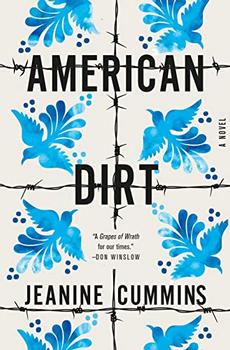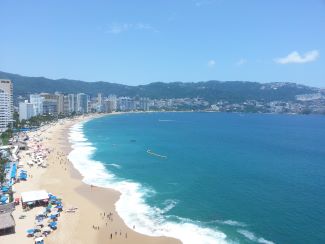Summary | Excerpt | Reading Guide | Discuss | Reviews | Beyond the Book | Read-Alikes | Genres & Themes | Author Bio

A Novel
by Jeanine CumminsThis article relates to American Dirt
 Acapulco de Juárez, commonly known as Acapulco, is a city located on the coast of Mexico in the southwestern state of Guerrero. The name "Acapulco" is believed to come from a word in the Náhuatl (Aztec) language meaning "place of the reeds." Once considered a desirable vacation spot and bustling resort town, Acapulco has in recent years been overrun by gang violence, becoming a threatening place for locals and losing much of its draw for travelers.
Acapulco de Juárez, commonly known as Acapulco, is a city located on the coast of Mexico in the southwestern state of Guerrero. The name "Acapulco" is believed to come from a word in the Náhuatl (Aztec) language meaning "place of the reeds." Once considered a desirable vacation spot and bustling resort town, Acapulco has in recent years been overrun by gang violence, becoming a threatening place for locals and losing much of its draw for travelers.
The modern-day Guerrero region was inhabited by the Mezcala people starting in the 7th century, and shows evidence of earlier ties to the ancient Olmec civilization. The Aztecs gained control of the area in the 11th century, but failed to conquer Acapulco, which remained under local rule. Spanish conquistadors took over the city in the 1500s, turning it into a significant port serving international trade routes. During the Mexican War of Independence in the early 1800s, when the country fought for freedom from Spanish colonial power, the eventually-successful revolutionary army led by José Morelos was formed in Acapulco. Independence ended Spanish trade routes through the city. However, in 1927, the building of a highway between Acapulco and Mexico City opened up new possibilities for tourism and development.
The city began to come into its own as a resort destination starting in the 1930s and '40s, and became a playground for the rich and famous, hosting the likes of Rita Hayworth, Elizabeth Taylor, Eddie Fisher and Debbie Reynolds. Acapulco was featured in the 1963 Elvis Presley musical comedy Fun in Acapulco. In the following decades, it continued to enjoy a reputation as a tourist hotspot. It became a popular spring break getaway for American college students in the early 2000s.
While the movement and availability of drugs existed in Acapulco alongside its reputation as a party destination for some time, a shift took place in 2006—according to some residents—when violence broke out between competing cartels involved in trafficking in the area. Later that year, then-president Felipe Calderón began cracking down on drug traffickers throughout the country using military means. Since then, Acapulco has become a place where cartels fight federal forces and one another. One reason for this concentration of violence in Acapulco specifically is cartel competition over the Guerrero opioid trade, which is heavily supported by the U.S. illegal drug market. In recent years, as much as 90 percent or more of heroin that ends up in the U.S. is believed to have come from Mexico, with a large amount of the poppy used to produce it being grown in the Guerrero mountains. This was cited by the Trump administration as a reason for increasing U.S. border security to guard against illegal entry, but experts say several factors make it highly unlikely that these increased security measures would stem the flow of opioids into the United States—one of them being that the majority of drugs pass into the country through legal entry points.
Today, Acapulco is controlled by drug cartels and has one of the highest murder rates in the world. Residents are caught in an uneasy relationship with the ruling systems of organized crime along with the local government and police force, which are also controlled by the cartels. Many businesses and individuals working within the surviving Acapulco tourism industry are forced to make regular payments of extortion money under threat of violence.
While Acapulco remains one of the most dangerous cities in Mexico (and, in fact, anywhere), the cartels that threaten the safety of its people are part of a larger problem of gang control in Mexico and Central America fueled by an international drug market. The demand for drugs created by the U.S. opioid epidemic and the substantial number of legally-purchased American firearms crossing the border into Mexico continue to drive this problem, which in turn continues to drive those affected by it to seek asylum at the U.S. border.
Acapulco, by ReyungCho
Filed under Places, Cultures & Identities
![]() This "beyond the book article" relates to American Dirt. It originally ran in January 2020 and has been updated for the
February 2022 paperback edition.
Go to magazine.
This "beyond the book article" relates to American Dirt. It originally ran in January 2020 and has been updated for the
February 2022 paperback edition.
Go to magazine.
Idealism increases in direct proportion to one's distance from the problem.
Click Here to find out who said this, as well as discovering other famous literary quotes!
Your guide toexceptional books
BookBrowse seeks out and recommends the best in contemporary fiction and nonfiction—books that not only engage and entertain but also deepen our understanding of ourselves and the world around us.